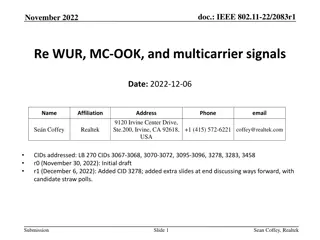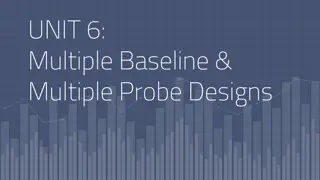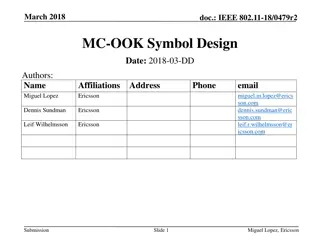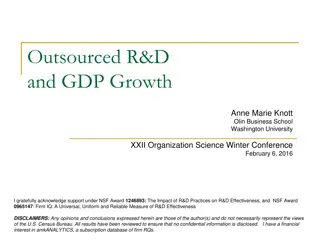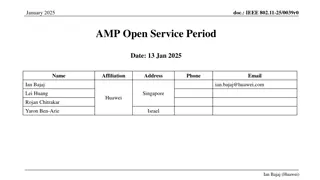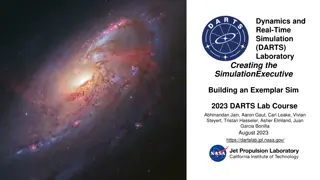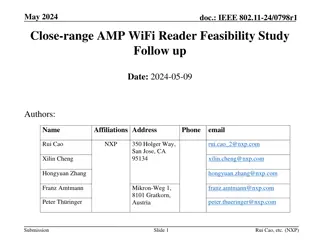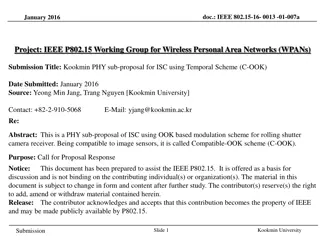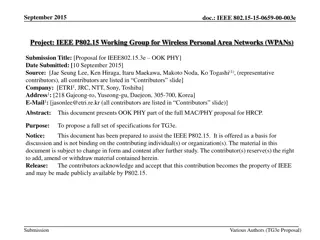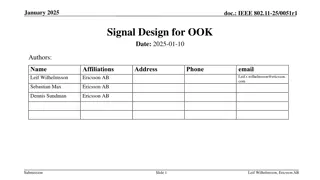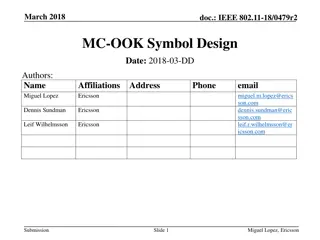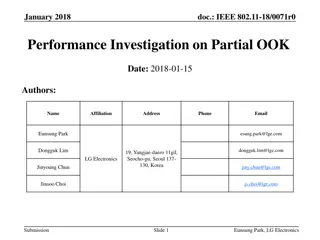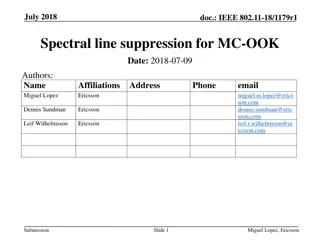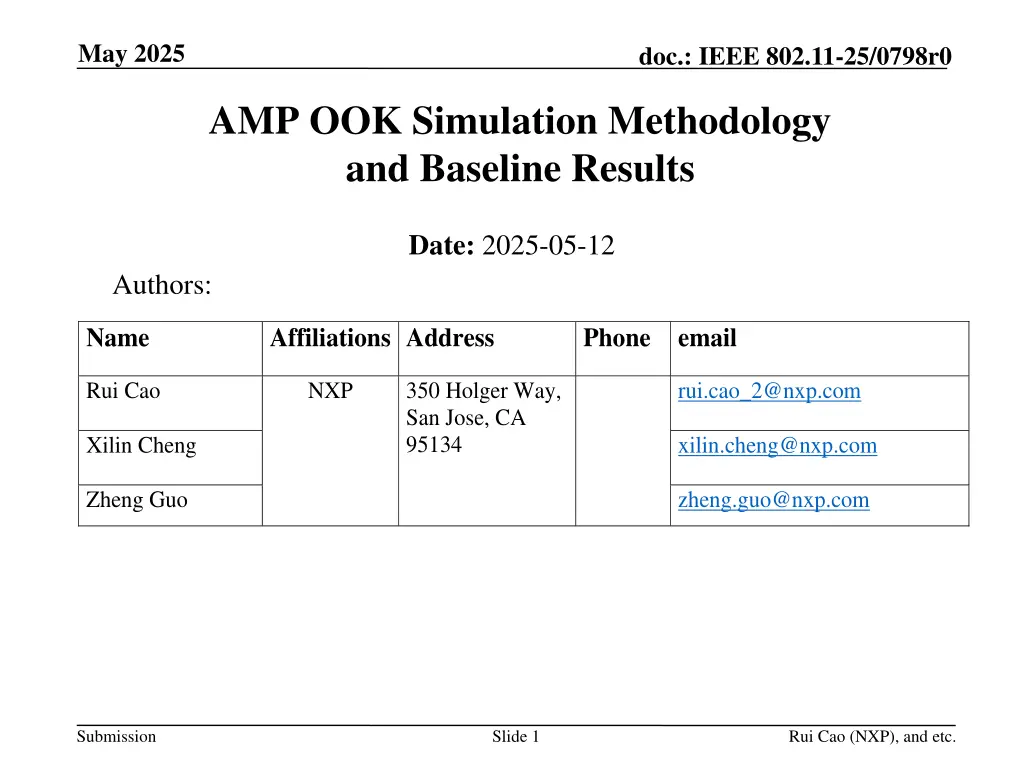
IEEE 802.11-25 OOK Simulation Methodology
Explore the simulation methodology and baseline results for IEEE 802.11-25/0798r0 AMP OOK modulation scheme. Learn about calibrating results, comparing designs, and modeling impairments for OOK performance evaluation.
Download Presentation

Please find below an Image/Link to download the presentation.
The content on the website is provided AS IS for your information and personal use only. It may not be sold, licensed, or shared on other websites without obtaining consent from the author. If you encounter any issues during the download, it is possible that the publisher has removed the file from their server.
You are allowed to download the files provided on this website for personal or commercial use, subject to the condition that they are used lawfully. All files are the property of their respective owners.
The content on the website is provided AS IS for your information and personal use only. It may not be sold, licensed, or shared on other websites without obtaining consent from the author.
E N D
Presentation Transcript
May 2025 doc.: IEEE 802.11-25/0798r0 AMP OOK Simulation Methodology and Baseline Results Date: 2025-05-12 Authors: Name Affiliations Address Phone email NXP Rui Cao 350 Holger Way, San Jose, CA 95134 rui.cao_2@nxp.com Xilin Cheng xilin.cheng@nxp.com Zheng Guo zheng.guo@nxp.com Submission Slide 1 Rui Cao (NXP), and etc.
May 2025 doc.: IEEE 802.11-25/0798r0 Introduction On-OFF keying (OOK) has been agreed as the modulation scheme for AMP As the group progresses to finalize the PHY design, it is important to align on the simulation methodology Calibrate the results among different contributions Compare the performance of various designs Main impairments to model for OOK performance Tag clock ppm Tag/Reader AGC behavior Submission Slide 2 Rui Cao (NXP), and etc.
May 2025 doc.: IEEE 802.11-25/0798r0 DL OOK Sim Diagram Reader Tag 2/4/8MHz 80MHz 1 80MHz 80MHz SYNC/Data detection Envelope detector down-sample ppm AWGN + AGC Base waveform resampling 2 3 4 channel 0 1 1 0 0 OOK Modulation 2: AWGN + AGC model Normalize noise to x dB Scale OOK signal accordingly to SNR ADC quantization Ideal setting: X = 0dB, ADC quantization omitted Practical setting: X = -6dB (SNR ceiling) 3~4 bit ADC quantization 1: base waveform of duration W (us) Pulse, OFDM, and random polarity added 3: Tag clock ppm resampling: Random first sample delay: [0, 80*W] Resample the Rx signal at 80MHz * (1+ppm) 4: Envelope detector and down-sample: ED output = sum(|y|) / (1+ppm), sum over 80MHz/clock_rate samples ED output at clock rate, 2MHz/4MHz/etc. Submission Slide 3 Rui Cao (NXP), and etc.
May 2025 doc.: IEEE 802.11-25/0798r0 UL OOK Sim Diagram Reader 20MHz 1 20MHz Base waveform AWGN+ AGC 3 SYNC/Data detection 4 ADC Tag 3: AWGN + AGC model Normalize noise to x dB Scale OOK signal accordingly to SNR ADC quantization Ideal setting: X = 0dB, ADC quantization omitted Works for active Tx UL Practical setting for BS: X = -12dB or other number 10-bit ADC quantization 4: Data detection: Coherent or Non-coherent 0 1 1 0 0 ppm OOK resampling Modulation Tag clock 2 channel 1: Base waveform of duration W (us) Pulse, OFDM, and random polarity added 2: Tag ppm resampling Random first sample delay: [0:0.25:20*W] Resample the signal at 20MHz * (1+ppm) Submission Slide 4 Rui Cao (NXP), and etc.
May 2025 doc.: IEEE 802.11-25/0798r0 Simulation Settings Simulation diagram: Slide 3 and 4 Carrier waveform: Pulse: square pulse OFDM: L-LTF Detectors Coherent and non-coherent Ideal timing and per-bit re-timing Ideal AGC Clock accuracy: 0 ppm Payload: 100 bits Submission Slide 5 Rui Cao (NXP), and etc.
May 2025 doc.: IEEE 802.11-25/0798r0 DL OOK Baseline Results: 250kbps Submission Slide 6 Rui Cao (NXP), and etc.
May 2025 doc.: IEEE 802.11-25/0798r0 DL OOK Baseline Results: 1Mbps Submission Slide 7 Rui Cao (NXP), and etc.
May 2025 doc.: IEEE 802.11-25/0798r0 DL Sim Baseline Results: Summary Sensitivity 250kbps, non-Coherent 1Mbps, non-Coherent Ideal Timing Non-Ideal Timing Ideal Timing Non-Ideal Timing Pulse -7 -6.3 -3.3 -2.6 OFDM -6.9 -6.2 -3.0 -2.2 Performance of OFDM carrier waveform is similar to pulse carrier Per-bit timing has ~0.7dB loss from ideal timing Submission Slide 8 Rui Cao (NXP), and etc.
May 2025 doc.: IEEE 802.11-25/0798r0 BS Sim Baseline Results: 250kbps Submission Slide 9 Rui Cao (NXP), and etc.
May 2025 doc.: IEEE 802.11-25/0798r0 BS Sim Baseline Results: 1Mbps Submission Slide 10 Rui Cao (NXP), and etc.
May 2025 doc.: IEEE 802.11-25/0798r0 BS Sim Baseline Results: Summary Sensitivity 250kbps, non-Coherent 1Mbps, non-Coherent Ideal Timing Non-Ideal Timing Ideal Timing Non-Ideal Timing Pulse -3.5 -2.6 0.3 1.4 OFDM -3.4 -2.4 0.7 2.1 Sensitivity 250kbps, Coherent 1Mbps, Coherent Ideal Timing Non-Ideal Timing Ideal Timing Non-Ideal Timing Pulse -9.3 -7.4 -3.3 -1.2 OFDM -9 -7.3 -2.9 -0.6 Performance of OFDM carrier waveform is similar to pulse carrier (<1dB) Per-bit timing has 1~2dB loss from ideal timing Coherent detector has ~5dB gain for 250kbps and ~3dB gain for 1mbps Submission Slide 11 Rui Cao (NXP), and etc.
May 2025 doc.: IEEE 802.11-25/0798r0 Discussions Carrier waveform for simulation Square pulse waveform is slightly better than 20MHz OFDM The detector type has big impact to the performance Simulation setting suggestions: Rx waveform: x us noise before actual PPDU Test SYNC false trigger rate from noise Backscattering tag: 400us noise before actual PPDU +/-10% of ~2ms tag processing time Non-backscattering tag: 5ms Tag clock ppm: Backscattering Tag with OOK modulation: 100kppm Active Tag: 1000ppm for Tx, 10kppm Rx? AMP enabled WiFi: 1000ppm for Rx? Submission Slide 12 Rui Cao (NXP), and etc.
May 2025 doc.: IEEE 802.11-25/0798r0 SP Do you agree to simulate OOK performance using the diagram as show in slide 3 and 4? Note: opinion collection Submission Slide 13 Rui Cao (NXP), and etc.
May 2025 doc.: IEEE 802.11-25/0798r0 SP Do you agree to add the following 11bp SFD? The maximum allowed clock inaccuracy for the backscattering tag using OOK modulation is 100,000 ppm for both receive mode and backscattering transmit mode? Submission Slide 14 Rui Cao (NXP), and etc.


